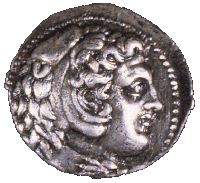Economy
Coinage

 The use of coins started in the Late Bronze Age and Early Iron Age.
Goods were bartered first for cast bronze ingots and later for small
pellets called "dumps." When the dumps were marked with an emblem
guaranteeing their value and origin, they became in effect the first
true coins. These appeared around 650 BC in western Anatolia.
The use of coins started in the Late Bronze Age and Early Iron Age.
Goods were bartered first for cast bronze ingots and later for small
pellets called "dumps." When the dumps were marked with an emblem
guaranteeing their value and origin, they became in effect the first
true coins. These appeared around 650 BC in western Anatolia.
 By 600 BC Lydian regal coins were made of electrum, a natural alloy
of silver and gold; electrum was adopted by the Asia Minor Greeks for
their coins as well. Later, many Greek city-states adopted silver. In
the later 5th century BC, small change in bronze made its first
appearance, supplementing the silver issues. Except for Lydian and
Persian coins, gold was used only sparingly until the middle of the
4th century BC
By 600 BC Lydian regal coins were made of electrum, a natural alloy
of silver and gold; electrum was adopted by the Asia Minor Greeks for
their coins as well. Later, many Greek city-states adopted silver. In
the later 5th century BC, small change in bronze made its first
appearance, supplementing the silver issues. Except for Lydian and
Persian coins, gold was used only sparingly until the middle of the
4th century BC
During the Hellenistic period gold, silver, bronze
and occasionally electrum were all used for public and private
commercial exchange throughout the Mediterranean. Many variant weight
standards for coins were used throughout the Greek world.
Obol, litra, stater, drachm,
didrachm, tetradrachm, octodrachm, and
decadrachm are terms for some of the more common coins.



The Ancient Greek World Index

